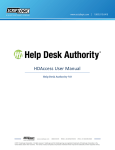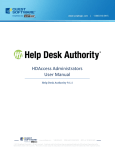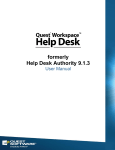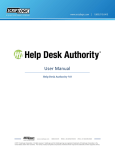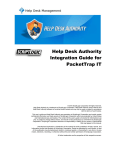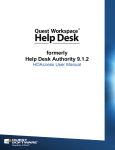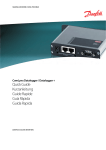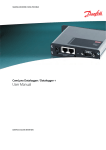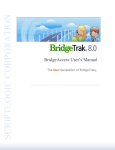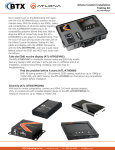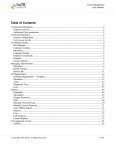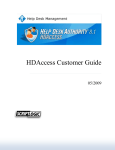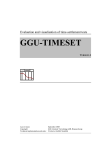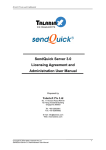Download HDServer Modules User Manual
Transcript
HDServer Modules User Manual Help Desk Authority 9.0 © 2011ScriptLogic Corporation ALL RIGHTS RESERVED. ScriptLogic, the ScriptLogic logo and Point,Click,Done! are trademarks and registered trademarks of ScriptLogic Corporation in the United States of America and other countries. All other trademarks and registered trademarks are property of their respective owners. 2 | HDServer Modules User Manual Contents Contents ......................................................................................................................................... 3 Overview ........................................................................................................................................ 5 HDAutoEscalate ............................................................................................................................ 6 Email Settings ............................................................................................................................ 7 Message Log Settings ................................................................................................................ 8 Rules .......................................................................................................................................... 9 Defining a Rule .................................................................................................................... 10 Editing a Rule ...................................................................................................................... 24 Deleting a Rule .................................................................................................................... 25 Running a Rule .................................................................................................................... 25 The Rule Log List ................................................................................................................ 26 HDSearch ..................................................................................................................................... 28 Creating a Search Index ........................................................................................................... 28 Scheduling an Index ............................................................................................................. 29 Using HDSearch in Help Desk Authority................................................................................ 29 Viewing Search Results ....................................................................................................... 30 Refining a Search ................................................................................................................. 31 HDMail ........................................................................................................................................ 34 Configuration ........................................................................................................................... 34 The Mail Server Tab ............................................................................................................ 35 The Receive Email Tab ........................................................................................................ 36 The Auto-Response Tab ...................................................................................................... 38 The Issue Defaults Tab ........................................................................................................ 39 The Email Queue ..................................................................................................................... 40 Reviewing Email in the Queue ............................................................................................ 41 The Email History Log ............................................................................................................ 43 The Email Log ..................................................................................................................... 44 HDSync ........................................................................................................................................ 46 Creating Security Groups ......................................................................................................... 47 Defining the Domain................................................................................................................ 48 Define Rules............................................................................................................................. 49 3 | HDServer Modules User Manual To Define a Rule .................................................................................................................. 50 Editing a Rule ...................................................................................................................... 53 Deleting a Rule .................................................................................................................... 53 Setting Rule Priority ............................................................................................................ 53 Run the Synchronization Rules ................................................................................................ 53 Running a Rule Manually .................................................................................................... 54 Scheduling a Synchronization.............................................................................................. 54 HDAsset ....................................................................................................................................... 55 Starting HDAsset ..................................................................................................................... 56 Network Scan ........................................................................................................................... 57 The NetworkScan Toolbar ................................................................................................... 58 Scanning a Network ............................................................................................................. 58 Report Scheduler .......................................................................................................................... 62 Configuration ........................................................................................................................... 62 Adding a Schedule ................................................................................................................... 63 Adding Reports to a Schedule.................................................................................................. 65 Running the Schedule .............................................................................................................. 66 Refreshing the Schedule List ............................................................................................... 66 4 | HDServer Modules User Manual Overview This document contains complete instructions for the HDServer Modules. Those modules consist of the following: • • • HDAutoEscalate HDSearch HDMail • • • HDSync HDAsset Report Scheduler This document can be accessed from the Help menu of each Server module. 5 | HDServer Modules User Manual HDAutoEscalate HDAutoEscalate is a powerful Issue notification and escalation tool for Issue management. This Help Desk Authority companion tool allows you to define the criteria, also known as Conditions, to trigger escalations or notifications, called Rule Actions. Collectively, the Conditions and Rule Actions are called Rules. Once your Rules have been established, you can direct them to run automatically on a set schedule that you define or you can run them manually on an as-needed basis. Some examples of what HDAutoEscalate can be configured to do include: • • • • • • • Notify the Requester who reported the Issue when the Issue status changes. Notify the User who is assigned to the Issue when critical changes occur. Automatically change field values within the Issue in Help Desk Authority when certain conditions are met. Notify key people when there are changes to pertinent Issue fields in Help Desk Authority. Notify the user or manager when the due date of an Issue has been reached. Trigger notification based on your defined Issue actions such as “Issue Escalated”, “Issue Reassigned”, or “Issue Exceeds Time”. Automatically generate Issue reports and send them to your Requesters and Help Desk Authority Users. Because HDAutoEscalate actually accesses the Help Desk Authority database and manipulates data according to your Conditions and Rules Actions (i.e., Issue escalation), it is important that only one Rule is run at a time. For this reason, permissions to use HDAutoEscalate should be given to administrators only (Help Desk Authority > Administration > Security > Groups and Privileges – Grant Modules. HDAutoEscalate.Access). By using only one computer, Rule conflicts will be eliminated. 6 | HDServer Modules User Manual Email Settings In order for HDAutoEscalate to automatically generate and send email messages, Email settings must be established. To establish your email settings, open HDServer Modules | HDAutoEscalate | Email Settings. HDAutoEscalate will display the Email Settings window, shown below: 1. In the Sender’s Name field, enter the name that will appear on the From: line in HDAutoEscalate email notifications. 2. Enter a valid email address in the Senders Email Address field. This will be the email address from where the notifications are being sent. 3. In the Outgoing Mail Server field, enter the address of your company’s outgoing mail server (this will usually start with SMTP). 4. Enter the correct port number in the Port Number field. 5. Check the Use SSL checkbox if you will be using SSL for your email. 6. If your email server requires authentication, check the My server requires authentication checkbox. 7. If necessary, enter the appropriate user name and password in the User Name and Password fields. 8. If you would like HDAutoEscalate to create an Issue Activity for each email notification, check the checkbox. 9. Use the Test Connection button to make sure the settings you have entered are correct. If they are, a “Test Connection Successful” pop-up alert will notify you. 7 | HDServer Modules User Manual Message Log Settings HDAutoEscalate will write entries to its own Rule Log in order to record the actions taken for a particular Rule and Issue, as well as to note any errors or exceptions that occurred during processing. The Rule Log consists of three separate logs: the Email Log; the Field Change Log; and the Message Log. The purpose of the Message Log is to record any exceptions that occur during rule processing (errors, actions that could not be taken because of missing email addresses, etc). The Rule Log is explained in more detail in the Rule Logs section of this guide. Depending on the number of Issues in your Help Desk Authority database, as well as the number of Rules you have defined and the frequency at which you run them, the Message Log has the potential to grow very large. Each record written to your Message Log is one row written to your Help Desk Authority database. To avoid unmanaged growth of your database, you should specify a maximum number of records to be written to your message log before the log is pruned. Pruning will cause the oldest records in the Message Log to be deleted, bringing the total number of records down to the limit you designate. To designate a maximum number of rows for your Message Log: 10. Click the Error Log Settings icon in the toolbar. This will open the Message Log Settings window. 11. In the Maximum Rows allowed in Message Log text field, enter the number that will represent the maximum number of rows that can be written before pruning of the database begins. 12. There is also an option regarding whether or not a record should be written to the Message Log if a Requester or User is missing an email address. Check if appropriate. If an HDAutoEscalate rule determines that an email should be sent to a User or Customer, but that User or Customer does not have an email address in their Help Desk Authority record, then obviously an email cannot be sent. You may or may not want a record written to your Message Log every time this occurs. It may be valuable information, but depending on whether or not you review the message log regularly and take action to enter the missing email addresses; this could cause a high number of entries to be written to the log. 8 | HDServer Modules User Manual Rules HDAutoEscalate centers on rules. A rule is one or more “Conditions” pertaining to an Issue that cause one or more “Rule Actions” to occur. For example, a rule might stipulate the following: Condition Rule Action If the Priority is Urgent, and the Category is Hardware send an email to Bob HDAutoEscalate is designed to act on Issues, and only Issues. An HDAutoEscalate Condition is true for one Issue at a time. Rule Actions are triggered one at a time for each Issue that meets the condition. For each HDAutoEscalate rule, the condition will be evaluated against each Issue in the Help Desk Authority database, and the Rule Action will be triggered for each Issue found to meet the condition. The main window of HDAutoEscalate is comprised of the menu tree in the left pane, a toolbar, and the Rules list in the large pane below the toolbar. To refresh this list at any time, click the button. A rule is comprised of three components: • • • Conditions that tell HDAutoEscalate what must occur within Help Desk Authority for a resulting Rule Action to be triggered. Rule Actions which tell HDAutoEscalate what to do when the specified Conditions are met. The Schedule that tells HDAutoEscalate when to execute the rule. 9 | HDServer Modules User Manual To create a rule, you must open the Rule Configuration window. Click the button in the toolbar. The Rule Configuration - Add window is shown below. Defining a Rule When you open HDAutoEscalate, the rules that have been defined for your organization will be displayed in the rule list that comprises most of the window. Listed will be the rule name, when it was last run, when the next run is scheduled, and its active/inactive status. To Define a New Rule 1. Open the Rule configuration – Add window as shown above by clicking the 2. In the Rule Name field, enter a name for the new rule. This is required. button. The remaining steps for Rule configuration are defined in the four sections below, each corresponding to a tab in the Rule configuration – Add window. 10 | HDServer Modules User Manual The Conditions Tab As discussed earlier, a Condition must be met in order for its Rule Action to take place. A Condition may consist of any combination of the following seven events: 1. 2. 3. 4. 5. 6. 7. An Issue satisfies the criteria of a Help Desk Authority Query. An Issue has passed its due date. A specified amount of time has passed since the Issue has been open. There has been a change in a specified field for a Help Desk Authority Issue. A specified Activity has been entered in Help Desk Authority for the Issue. An Issue status changes. A specified Asset type is assigned to an Issue. An Issue Satisfies the Criteria of a Help Desk Authority Query Queries are an integral part of Help Desk authority. They search and retrieve Issue data based upon certain conditions. Once a Query has been defined in Help Desk Authority, it can be used in HDAutoEscalate as a condition. To create a condition based upon a Query: 1. Select a Query from the Issues meeting this query’s criteria drop-down menu as shown below. An Open Issue Has Passed its Due Date This Condition acts on the Due Date field in an Issue. The top left of the Conditions tab shows the following checkbox: To create a condition based upon an open, past-due Issue: 1. Check the checkbox labeled “Trigger action when an Issue is open and past its due date” as shown below. A Specified Amount of Time Has Passed Since the Issue Has Been Open This Condition acts on the amount of time an Issue has been open. The top right of the Conditions tab shows the following checkbox: 11 | HDServer Modules User Manual To create a condition based upon an issue that has been open for a specified amount of time: 1. Check the Trigger Action when Issue has been Open for the following length of time or more checkbox. This will activate the fields for Days, Hours and Minutes. 2. Enter values for the Days, Hours and Minutes fields as necessary. There Has Been a Change in a Specified Field for a Help Desk Authority Issue Because Conditions are tied to the fields which comprise an Issue in Help Desk Authority, changes in these fields can initiate an action in HDAutoEscalate. By using the Trigger Action when these Fields Change tab, you can specify which fields, when changed, should initiate an action. This tab contains two panes: Available Fields and Selected Fields. The Available Fields pane lists fields that are used in the Issue window in Help Desk Authority. The Selected Fields pane will list the fields you have selected upon which to build your condition in the event of a change in the fields. By selecting the fields from the Available Fields pane, you are telling HDAutoEscalate to check if there has been a change in the field value of the selected field. A change will trigger a Rule Action. 12 | HDServer Modules User Manual A Specified Activity Has Been Entered in Help Desk Authority for the Issue The resolution of an Issue can involve many actions. In Help Desk Authority, these actions are called Activities. Each Activity that is performed to resolve an Issue is recorded on the Activity tab of the Issue window. Each Activity that is recorded usually involves a different action. In Help Desk Authority, these actions are called Activity Types. These Activity Types are meant to serve as an audit trail of steps taken to resolve a support request, with Activity Types tracking actions from Help Desk Authority Users as well as HDAccess customers. Activity Types are initially defined via Setup | Define Tables | Issue Activity Types in Help Desk Authority. Activity Types are completely customizable and will change from installation to installation. The Issue Activity Type Condition will begin at the time the Rule is first scheduled to run and continue forward. Issues with Activity Types that were changed before the Rule is first scheduled to run will not be affected. After Activity Types have been defined and then assigned to Issues in Help Desk Authority, they can then be used in HDAutoEscalate to define a Condition. In the “Issue Activity is entered” tab, 13 | HDServer Modules User Manual An Issue Status Changes The third tab in the Rule Configuration – Add window is “Issue Status Changes to”. Here you can trigger an action when the status of an issue changes to a specified status and sub-status. A Specified Asset Type is Assigned to an Issue Some Assets are more important than other Assets. HDAutoEscalate will send notifications to all stakeholders when Issues with these Assets are assigned. On the Type of Asset Assigned is tab, select the Trigger action when the type of the assigned asset is check box and select the required asset type in the drop down list. 14 | HDServer Modules User Manual The Rule Actions Tab After your Rule Conditions are defined, the next step is to establish what must occur when the Condition is met. In HDAutoEscalate, this is called a Rule Action. A Rule Action can be one or both of the following: • • Sending an email message to specified recipients Changing the value of selected fields in an Issue in Help Desk Authority There are two tabs under the Rule Actions tab; People to Notify tab and the Change Fields Tab. 15 | HDServer Modules User Manual People to Notify Tab To select people to notify: 1. Check the appropriate checkboxes for those you would like to be notified; Assigned User, Requester who reported the Issue, Issue Subscribers or User who created the Issue. All people checked will appear in the grid below the checkboxes. 2. In the Notification Frequency column of the grid, select the radio button for a single notification (Notify Once) or multiple notifications (Notify Every). 3. If you selected Notify Every, enter the number of days, hours and minutes between notifications in the days, hh and mm fields. 4. Enter a number for maximum notifications in the Max field if you would like to limit the number of notifications for a given person. 16 | HDServer Modules User Manual Selecting specific people to notify Below the selection grid is a row of buttons for selecting specific people to notify. Using these options will allow you to select a much more specific user or group of users. To enter specific email addresses, click the Notify specific email addresses button. This will open the NotifyEmailAddress window. 1. 2. 3. 4. Enter the email address of the person you would like to notify in the Email Address field. Click the Add Address button. Enter the notification frequency for the individual as described above. Click the OK button when all addresses have been entered and configured. 17 | HDServer Modules User Manual To notify a group of people, click the Notify Group button. This will open the Select Group window. 1. Select the group you wish to notify. You can select multiple groups by holding the Ctrl key while clicking. 2. Click the OK button when the desired groups have been selected. 3. The groups you selected will now be in the grid. Enter the notification frequency information as described above. 18 | HDServer Modules User Manual If you would like to notify a specific user or users, but you don’t have the contact information, click the Find User button. This will open the User Details window. 1. Enter the information you know in the Full Name, Logon Name and/or Primary Email fields. 2. Click the Search button. Or, click the Clear Search button to start over. Any results will appear in the name grid below the search area. 3. Select a person or several people from the list and click the OK button. The User Details window will close and any names you selected for notification will now appear in the grid. 4. Enter the notification frequency information as described above. 19 | HDServer Modules User Manual To notify a specific Requester or Requesters, click the Find Requester button. This will open the Requester window. 1. 2. 3. 4. Enter any search criteria that you know if you wish to search for a Requester. Click the Search button. Click the Reset button to clear the search fields and start over. Select any Requester or Requesters from the search results list and click the Select button. If you would like to add a Requester, click the Add button. This will open the Requester – Add window. Follow the instructions in the Help Desk Authority Users Manual for adding a Requester. 5. Once your selected Requesters are visible in the grid, you can configure their notification frequency information. 6. When finished adding any people to notify, click the OK button. 7. To delete any names in the grid, select the name and click the Delete button. 20 | HDServer Modules User Manual The Change Fields Tab When an Issue(s) meets the specified condition, you can direct HDAutoEscalate to automatically change certain Issue field values within Help Desk Authority. This is done in the Change Fields tab as shown below. The fields shown here correspond with the Priority, Category, Assigned Group, Assigned User, Status, and Sub-Status fields in Help Desk Authority. Select new values from the appropriate drop-down menus for the fields you would like to be changed as a result of the Rule action. The Category field name is actually a button that will open the Issue Categories window shown below. Drill into the tree structure to find the exact category you would like to use. The path will now be shown in the Category field. 21 | HDServer Modules User Manual The Custom Message Tab The Custom Message tab of the Rule Configuration – Add window is used for setting up a custom notification email that is sent when the action is triggered. 22 | HDServer Modules User Manual To configure a custom email notification message: 1. In the Email Template drop-down menu, select a pre-configured email template. 2. If there are no pre-configured email templates to choose from, or if you would like to create a new one, click the button to open the Email Template – Add window. 3. To edit the chosen template, click the button to open the Email Template – Edit window. 4. The “Text to appear in “Subject” area of notification email” and “This message will be sent in the body of the email, and will appear before Issue report” fields will be prepopulated with information from the email template you have selected. The only way to edit these fields is to edit the email template. 5. If you would like to configure global Accept/Reject settings in this new Rule for closed Issues, click the “Global Accept/Reject Issue Settings“ link. This will open the Accept/Reject Settings window. If you would like to skip this step, go to the next section (the Schedule tab). 6. Enter the URL for HDAccess in the HDAccess URL field. This field is required. 7. Under Accept Action, the Status: field will be locked and set at Closed. You may enter a Sub-Status from the Sub-Status: drop-down menu. 8. Under Reject Action, select the status that the Issue will be set to if you reject the Issue resolution. You can select the status from the Status: drop-down menu and a sub-status from the Sub-Status: drop-down menu. 9. Click the Save button. 23 | HDServer Modules User Manual The Schedule Tab You can choose to run the new rule manually or set it to a schedule. 1. If you will be scheduling this rule, un-check the “Do not schedule (Rule must be run manually)” checkbox. 2. If you would like to run the rule manually at any time, click the Run Rule button. In the popup confirmation window, click the OK button. 3. Select either the Hourly or Daily radio button depending upon how often you would like to run the rule. a. If you choose Hourly, enter a value for Run every Hours and Minutes. b. If you choose Daily, enter the time to run the rule in the “Run the rule at this time:” field. Then select the radio button for Every # days and enter a number OR the radio button for Every Day. 4. As noted on this screen, Scheduling a rule will not cause it to run unless HDAutoEscalate service has been started. Click the Start Service button to start the service. 5. If you would like the rule to run during business hours only, check the “Run the rule during business hours only” checkbox. 6. When your rule has been configured to your satisfaction, click the OK button in the bottomright corner of the Rule configuration window. Editing a Rule To edit a rule: 1. Select the rule from the list and click the button on the toolbar. You can also double-click the rule. Both actions will open the Rule Configuration – Edit window. 2. Complete the necessary changes in each tab. 3. Click the OK button in the bottom-right corner of the window when finished. 24 | HDServer Modules User Manual Deleting a Rule To delete a rule: 1. Select the rule from the list and click the button. 2. In the confirmation pop-up window, click the OK button. Running a Rule To run a rule: 1. Select the rule you would like to run. 2. Click the button. 3. You will receive a pop-up confirmation for the rule execution. 25 | HDServer Modules User Manual The Rule Log List Each time a rule runs, HDAutoEscalate records the results in the Rule Log List. You can view the Rule Log List at any time. Rules that result in an email notification are recorded in the Email Log. Rules that result in a field value change in an Issue are recorded in the Field Change Log. Any exceptions that occur during the execution of a rule are recorded in the Message Log. To view the Rule Log List for a rule, select the rule and click the Rule Log List window shown below. button. This will open the Viewing the Rule Log List The Rule Log list is comprised of a Search section and a 3-tab viewing section to view the results of the search. To Search the Rule Log List 1. 2. 3. 4. The Rule Name field is automatically populated with the name of the rule. Enter the Start Date and End Date in the drop-down calendars. Click the Search button. Use the Reset button to reset both date fields if you would like to perform another search. 26 | HDServer Modules User Manual The Email Log Tab The list in the Email Log tab consists of emails sent. These emails are identified by the Issue No., Notification Date and Time, Email address and Notification Frequency. The Field Change Tab The Field Change Log tab consists of the Issue number, Date and Time, and Remarks for each change in a field relating to the rule. This log can be cleared by clicking the Clear Log button. Help To access the HDAutoEscalate documentation, click the version of the documentation. button. This will open the latest The Help menu in the main menu provides other options for seeking assistance, such as a link to the Contact Us page on the ScriptLogic website, a link to the ScriptLogic website itself, and an About window for HDServer Modules. 27 | HDServer Modules User Manual HDSearch The HDSearch query tool expands the capabilities of Help Desk Authority by providing immediate search results that can encompass your entire database of Issues, Knowledge Base Articles, and file attachments. If you choose, you can even include your entire Help Desk Authority database (Requesters, Companies, Assets, etc.). By creating a search index that contains all text in the Help Desk Authority database, you can instantly find critical information for you and your Customers. When the search index is created, words that are too common to be useful in a search (if, and, the, etc.) are automatically eliminated. The search index enables HDSearch to quickly locate and retrieve important information. Note, however, that the information found with HDSearch will only be as accurate and up-to-date as the search index you create. If information in the Help Desk Authority database has been updated, and you have not updated your search index, the new information cannot be retrieved via HDSearch. It is recommended that you update the search index on a regular basis. If you choose, you can set up a schedule to have HDSearch automatically create the Index. You can access HDSearch in the navigation bar of the HD Server Modules application. Creating a Search Index When creating a search index, there are several options available that will give you more control over your search results. Each option is described below. 1. In the “Contents to Index” section, Enter the location of your SQL Server database in the MS SQL Server database field. Check the Index All Tables checkbox if you would like the index to use all tables in your database. If you do not check the checkbox, the tables indexed will be Company, Requester, Issue and Knowledge Base 2. Enter the location of your attachments folder in the Attachments Location field. If you have previously defined this location in Help Desk Authority under System Options (most cases), the file path will already be in the field, and the field will be grayed out. Check the Index Attachments checkbox if you would like HDSearch to index your attachments. 3. Check the Case Sensitive Index checkbox if you would like to create a case sensitive index. Under this option, words with the same spelling but different capitalization would be treated as individual words (i.e. Printer, printer and PRINTER). If you leave this checkbox unchecked, it will treat all words spelled the same as one word. 4. In the “Index Files Location” section, Select the location for your index files in the Index Location field. You can use the browse button to locate the folder on your local machine or network. If the location you choose will be on a network, browse to the folder and 28 | HDServer Modules User Manual select it, then click the Network button to generate the UNC path. Note that if you have configured this location in Help Desk Authority under System Options, 5. Click the button in the toolbar to generate the index. “Indexing Complete” will appear in the bottom of the window when the index has finished building. 6. Click the button in the toolbar to save these index settings. 7. Click the button in the toolbar to start the HDSearch service. The button will change to time. 8. Selecting the and will be used to stop the HDSearch service at any button will open the HDSearch User Manual in PDF. Scheduling an Index HDSearch gives you the option to automatically index your database and/or file attachments according to a schedule that you define. The schedule can be defined to run at a specific time on specific days. Since it runs as a service, it is not necessary to have Help Desk Authority or the HDA Server Modules running. 1. Click the button in the toolbar. This will open the Schedule window. 2. Check the Enable Schedule checkbox. 3. In the Time field, enter the time of day (or night) you would like to schedule the service to run. This field is required. 4. Check the checkbox next to each day that you would like the schedule to run. 5. Click the Start Service button. It will change to read “Stop Service”, and you will use it to stop the service when you need to. Using HDSearch in Help Desk Authority After your Search Index has been created in HDSearch, you can put it to use in Help Desk Authority to quickly find the information you need. To launch HDSearch, locate the search box in the upper-right corner of the window. Enter your search word or phrase in the search box and click the Search button. This will open the HDSearch window. 29 | HDServer Modules User Manual Viewing Search Results After you have performed a search, the HDSearch window will open with the search results. From here, you can refine your search, perform a new search, and review your search results. Your results are found in the results window. The tabs on the left are the tables that are searched, and the total number of results in each table will be in parenthesis next to the table name. To view results from another table, click that tab and the results window will show any results that correspond to that table. 30 | HDServer Modules User Manual You can also look deeper into your results by clicking on a result and then clicking the View button (note that you can also just double-click on a result). Depending upon the type of result, you will be presented with a different “container” for your data. See the table below for more information. Table Containing the Result Window Opened Issues The Issue window Companies The Company record in the Company window Requesters The Requester record in the Requester window. Assets The Asset record in the Asset window. KBase Articles The Knowledge Base article Miscellaneous Depending on the result, you will see the area of Help Desk Authority where the informati0on was found. Attachments The actual file attachment will open for viewing Refining a Search There are three sections in HDSearch for refining your search: • • • Search For Search Features Search Terms Search For 31 | HDServer Modules User Manual Select Any Words, All Words or Boolean Language with the appropriate radio button. All three are explained below. Option Description Any Words Finds instances containing any of the word(s) (one or more) entered in the Search Request pane. All Words Finds instances containing each and every word entered in the Search Request pane. Boolean Language Boolean search requests consist of words or phrases linked by “And”, “Or”, and “Not”. When you select the Boolean Language option, the And, Or, and Not buttons are enabled. The Fields button in the Search Terms section is also enabled. Click on And, Or, and Not when appropriate to compose your Boolean search statement. (For more information, see “Boolean Searches” in the section that follows.) Boolean Searches When you select the Boolean Language option, initially Help Desk Authority enables the Fields button to the right of the Search Terms field. When you begin typing in the text of your Search Terms, the remaining And, Or, and Not buttons are enabled. When you click on the shown below: button, Help Desk Authority will display a Fields List window, like the one The Fields List window displays all fields defined in your Search Index. You can use these fields when performing a search by clicking on the field in the list and then clicking on OK. Your selection will appear in the Search Request window, as shown in the example below: 32 | HDServer Modules User Manual Within the parentheses following the word “contains” you can enter text that you want to find. For example, the Company name of “Titan” was entered. When you click on Search, all instances where the Company Name field contains “Titan”, will be found. Search Features The three Search Features are explained in the table below. Feature Stemming Description Allows all grammatical variations of a word to appear in the search results. For example, if you were searching for the word “assign”, the search would also find “assigns” and “assigned”. Phonic Finds words that begin with the same letter and sound alike. For example, if you entered “pier”, the search results would display “pier” and “peer”. On the other hand, if you entered “hole”, the search results would display “hole”, but not “whole”. This is because, even though the words sound alike, they begin with different letters. Fuzzy Searching Enables you to find words that may be misspelled. Adjust the “fuzziness” on a scale of 1 through 10 using the track bar to the right of the feature. 10 represents the highest degree of misspelling. 33 | HDServer Modules User Manual HDMail HDMail expands your Issue Management capabilities by automatically converting emails arriving at your Help Desk into Help Desk Authority Issues. When you receive incoming emails from the Customers that you serve, you can choose to have the emails held in a queue for individual review, or they can automatically be turned into Help Desk Authority Issues. In addition, when emails are received, you can automatically generate a response. All of this can be set up to run without any User intervention. Configuration When you log on to HDMail for the first time, you will be prompted to configure your mail server before proceeding. Click the Yes button. This will open the Email Configuration Setup window. This window has four tabs. 34 | HDServer Modules User Manual The Mail Server Tab In order to send and receive emails, HDMail will need to know certain details regarding your email server. First, complete the Mail Server (Receive Email) section: 1. In the Mail System Desc. field, enter a description for the mail system you will be using for HDMail. 2. In the User Name field, enter your user name (often, this is a complete email address). 3. In the Password field, enter the email password. 4. In the Protocol drop-down menu, select the email protocol supported by your email system. 5. In the Mail Server field, enter the name of your mail server. 6. In the Port Number field, enter the port number for your email server. If you have selected POP3 from the Protocol drop-down menu, “110” will be automatically populated into this field. If you have chosen IMAP from the Protocol drop-down, “143” will be automatically populated into this field. 7. If you will be using SSL, check the Use SSL checkbox. 8. Click the Test Connection button to verify that your settings are correct. 35 | HDServer Modules User Manual Next, complete the Mail Server (Send Email) section: 1. In the Mail System Desc. Field, enter a description for the mail system you will be using for HDMail. 2. In the Sender’s Name field, enter the name that you would like to appear in the From: line of the outgoing email. 3. In the Email Address field, enter the email address that the mail will be sent from. 4. In the Mail Server field, enter the name of your outgoing mail server. 5. In the Port Number field, enter the port number used by your outgoing mail server. 6. If using SSL for outgoing mail, check the Use SSL checkbox. 7. Click the Test Connection button to verify that your settings are correct. 8. If your server requires authentication, check the My server requires authentication checkbox. 9. Enter your user name and password in the proper fields. You can also check the “Use receive mail username and password” checkbox to automatically populate these fields. 10. If you will be using Microsoft Outlook, check the Use Outlook checkbox. The Receive Email Tab When email is received, HDMail processes each message according to the settings that you define on the Receive Email tab of the Email Configuration Setup window, shown below: 36 | HDServer Modules User Manual Converting Email to Issues Email messages received through HDMail can be processed in one of two ways. Select the appropriate radio button for each: 11. The email messages can be held in a queue so that you can review each one before converting it to an Issue in Help Desk Authority. If you want to review all Issues coming into HDMail before deciding whether or not they should be converted into Issues, choose the Store all received email in a queue for manual review and processing radio button. 12. The email messages can be automatically converted into Issues in Help Desk Authority by selecting the Automatically convert email into Issues radio button and selecting one of the following options from the Convert drop-down menu: a. Only email from recognized* email address (Customers) b. Only email from recognized* email address or domain (Customers or Companies) c. All email regardless of email address or domain * Recognized email addresses refer to those email addresses or domains that are listed in the Help Desk Authority database and associated to a Help Desk Authority Customer or Company record. Choose This Option Result Only email from recognized email address (Customers) Convert only those emails coming from customers defined in the Help Desk Authority database into Issues. All unrecognized emails will be stored in the queue for manual review and processing. Only email from recognized email address or domain (Customers or Companies) Convert only those emails coming from Customers or Companies defined in the Help Desk Authority database into Issues. Unrecognized Emails will be stored in the queue for manual review and processing. All email regardless of email address or domain Convert all incoming emails into Issues. If the incoming email is not from a Customer or Company defined in the Help Desk Authority database, the Customer and Company fields on the Issue record will not be populated. 13. You can filter incoming emails by checking the checkbox labeled “Skip messages with subjects containing:” and entering characters into the text field. 14. Check the checkbox labeled “Leave a copy of message on server” if you would like to do so. 15. If you checked the checkbox in the above step, make sure you enter a value in the Remove from server after __ day(s) field. 16. Set the size of your email log by entering a value in the “Maximum Rows allowed in Email History log” field. 37 | HDServer Modules User Manual Process Attachments The emails that you receive may include file attachments. You can decide how you want to handle file attachments using the Attachments panel on the Receive Email tab of the Email Configuration Setup window. 1. If you would like to process attachments, check the Process attachments checkbox. 2. If you checked the checkbox above, you will need to select a folder to contain the attachments. In the Attachment field, click the browse (. . .) button and navigate to the folder of your choice. Click the OK button when finished. The folder path will now be displayed in the Attachment field. 3. You can filter out larger attachments by checking the “Skip attachment if the attachment size exceeds __ KB” checkbox. If you choose this option, enter the largest email attachment size you will allow in the space provided. 4. You can also filter out attachments with certain file extensions by checking the “Skip attachments with the extensions” checkbox. If you choose this option, enter the extensions you would like to filter out. Separate each extension by using commas. 5. Check the checkbox labeled “Use VCard attachments in emails to update requester data” if you would like to do so. Service Schedule The service schedule allows you to define how often HDMail checks for email messages. 1. The first field is “Interval to check mail for Auto Processing (In Minutes)” Enter a value in the textbox. This field is required. 2. On the same line is the Check Now button. Clicking the Check Now button will force HDMail to check for email messages. 3. You can choose to “Check mail only during business hours” by checking the checkbox. 4. Click the Start Service button to begin interval email checking. The Auto-Response Tab After telling HDMail to automatically respond to the emails it receives, you must then define what the response will be. This is done by creating an auto-response message. 1. Check the Enable Auto Response checkbox if you will be using an auto-responder. If not, leave the box unchecked. 2. Enter the subject line of your auto-responder in the Subject field. 3. Enter the body of your auto-responder email in the Body text box. You can insert one of seven different Issue fields in the body of the email using the Insert Field button. 4. You can include the Issue number in the subject by checking the “Include Issue Number in the subject” check box. 5. If you want to stop HDMail from sending an auto-response while you are already processing a reply to an Issue, check the “Do not send an auto response when processing a reply to an existing issue” checkbox. 6. In the ‘Default text to appear in all mails”, you can separate new content from existing content in Requester replies. HDMail will ignore the text or existing content below this default text when processing customer replies. The text might be something like, “Please do not type your response below this line.” 7. If you would like to add content found in new replies to an Issue, you can “Append to Issue Description” by checking that checkbox. 8. To remove auto-generated heading data created by outlook, check the checkbox labeled “Strip out the standard Outlook heading”. 38 | HDServer Modules User Manual 9. To treat the new content in customer replies as an issue activity, remove the check in the Append to Issue Description checkbox and check the Add an Issue Activity checkbox. The Issue Defaults Tab When an Issue is created from an email, it may also auto-fill certain tracking fields with default values. By default, the Issue Number, Date Received and “Open” Status are automatically pre-populated when an issue is converted from an email. You can set defaults for the Sub-Status, Assigned Group, Assigned User , Impact, Urgency and Priority fields. 1. For each field you would like to set to a default, select the default value from the drop-down menu. Note that if you are using the ITIL layout in HDAuthority, you can select an Impact and Urgency for the new Issue, and a Priority will be automatically assigned based upon the Priority Mapping grid. 2. Check the Grant Requester Self Service Login Privileges if you would like to automatically allow the Requester in the Issue to have access to HDAccess. Note that the Login name will be automatically populated in the Issue. You will need to enter a default password in the Password: field. a. Check the “User cannot change password” checkbox if you wish to withhold that privilege. b. Check the “User must change password at next login” checkbox if you will be requiring the user to set his or her own password upon first login. c. Select which Issues the Requester will be allowed to view and click the appropriate checkboxes for View Company Issues, View Department Issues and/or View Location Issues. When you have completed all four tabs in the Email configuration Setup window, click the OK button. 39 | HDServer Modules User Manual The Email Queue If you want to review the email messages coming into HDMail before they are converted to Issues, you can retain them in the HDMail Email Queue. Here they can be evaluated individually to determine which email messages should be converted to Issues in Help Desk Authority. Email waiting to be converted to Issues will appear in the email queue as shown above. To check for new mail, click the Check Mail button in the toolbar. When you manually check for mail, you will be presented with the following pop-up results window: Note that if you receive email through the scheduled service, you will not receive this notification. If your email service has not been started, click the Start Service button on the toolbar. The button will change to Stop Service, and will be used to stop the scheduled email service. The email queue will show all mail received based on the rules you have set up in the Email Configuration window. Emails will only appear in the queue if they have not been converted into an Issue. Each email in the queue will display Issue number (if the email is regarding an existing Issue), the 40 | HDServer Modules User Manual date and time of the email, who the email is from, the subject of the email, the number of attachments, and any recipients who also received the email (cc). Reviewing Email in the Queue To review a message in the Email Queue, select it and click the Open button on the toolbar (you can also double-click the email in the queue to open it). HDMail will display an Email Details window, like the one shown below: The Email Details window shows the actual email message. In this window you can edit the subject and body of the message. You can also view or remove any attachments from the message. To view an attachment, double-click on it and the file will open. To delete an attachment, select it and press the Delete key on your keyboard. 41 | HDServer Modules User Manual In addition, you can use the toolbar in this window to do any of the following: Create Issue Convert the email message to an Issue. When you click the Create Issue button, HDMail will display a message like “Generated Issue Number is – 179”. Click the OK button. An Issue will be created in Help Desk Authority with the number indicated,. The email message will then be automatically removed from the Email Queue. Append Issue Appends the email message to an Issue. When you click the Append Issue button, the Append Issue pop-up will open. Enter the Issue number you wish to append the email to and click the OK button. The email message will be appended to the issue. Reply Send a reply to the email message. When you click the Reply button, HDMail displays a Send Email window. Enter your reply, then click the Send icon to send the reply. Use this icon to send your reply to all recipients of the original email. Reply All Forward Forward the email message, along with its attachments, to another address. When you click the Forward button, a Send Email window will open. Enter the forwarding address, edit the message in any way that you like, then click n the Send icon. Delete Delete the email message from the queue without any action. When you click the Delete button, HDMail will display the message “Do you wish to delete the Email”. Click the OK button to confirm, or click the Cancel button to cancel it. Print a hard copy of the email message. Print 42 | HDServer Modules User Manual The Email History Log The Email History Log window is accessed by clicking the button on the toolbar. It displays a log of all emails processed by HDMail. To search the Email History Log for emails in a specific time interval, select the Start and End dates from the Start Date and End Date drop-down calendars, then click the Search button. An entry is automatically posted in the Email History Log table whenever HDMail checks for incoming emails, as specified on the Receive Email tab. An entry is also made each time you manually check for incoming emails by clicking the Check Now button. (For more information, see “Service Schedule” in this user’s manual.) 43 | HDServer Modules User Manual The email History Log contains the following information: Column Description Processed Date/Time The date and time that the incoming email message was processed. Total Email The total number of emails that were processed at the date and time displayed in the Processed Date/Time column. Emails Converted The number of emails that were converted to Issues at the date and time displayed in the Processed Date/Time column. Messages in Queue The number of emails that were placed in the Email Queue at the date and time displayed in the Processed Date/Time column. These emails have not yet been converted to Issues. Issues Appended The number of Issues that have an email response appended to them at the date and time displayed in the Processed Date/Time column. Deleted Issues The total number of issues that were deleted from the help desk using the HDMail delete issue option at the date and time displayed in the Processed Date/Time column. To delete any of the entries in the Email History table, select the entry and click the Clear button. To delete all entries from the table, click Clear All button. The Email Log Each entry in the Email History Log table has a corresponding Email Log. These logs can be viewed by double-clicking on the line item from the Email History table, or by selecting the line item and then clicking the Details button. When you click the Details button, HDMail will display the Email Log window, shown below: 44 | HDServer Modules User Manual This displays a list of all of the emails that were received during the Email History date/time line item selected. It shows the following information: Column Description Email Date/Time The date and time the message was received Issue No The assigned Issue number if the email has been converted to an Issue. From The email address of the sender Subject The subject of the email. To delete an entry in the log, select it and click the Delete button. To delete all entries in the Email Log, click the Delete All button. 45 | HDServer Modules User Manual HDSync User security and permissions in the Help Desk Authority suite are controlled by assigning users login rights and privileges. Many users of the Help Desk Authority suite rely on security groups to make the management of login rights easier. Security groups are based on your criteria, and you determine the permissions assigned to each group. This allows you to assign security and permissions for a group of users based on function, location or your preferred organizational scheme. HDSync allows you to incorporate users from your Active Directory user groups into Help Desk Authority as an individual user or into security groups. Integration into security groups is rules based. You specify the HDSync rules that designate which Active Directory entities should be associated with particular Help Desk Authority security groups. For example, you might specify that the AD (Active Directory) group “Help Desk Users” should have access to the full Help Desk Authority product and be given the application privileges defined in the Help Desk Authority security group “Help Desk Users”. Integration of your AD users as individuals is similar to the integration into security groups – although you don’t assign the users to a security group. Later you will have to assign permissions to these users on an individual basis. The synchronization can be on demand or on a scheduled basis. 46 | HDServer Modules User Manual To use the HDSync Tool you will need to be familiar with the following: • • • • Define Domain - Provide HDSync with the information necessary to access your Active Directory Define Help Desk Authority Security Groups – If you choose to use security groups you will need to define the permissions and priorities that characterize each group Define Rules - Define the rules by which your Active Directory users will be imported into the Help Desk Authority database, the security groups they are to be added to and the AD information about them you want to import Set Synchronization Schedule – If you want to execute the synchronization on a scheduled basis you will need to establish a synchronization schedule The following sections will provide the details required to implement each of these steps. Creating Security Groups If you plan to use security groups it is a good idea to define the groups in Help Desk Authority prior to synchronizing your Active Directory. Use the instructions below to create security groups and assign privileges to them. You do not need to assign users at this time as the synchronization will take care of that. To Create a Security Group: Add the Security Group 1. In Help Desk Authority click the Administration button in the toolbar, then under Security in the navigation pane, select Groups and Privileges. 2. In the Groups and Privileges window, on the Groups tab, click the Add button. 3. In the Groups – Add window, enter the name for the Group in the Group Name field. This field is required and it must be unique. 4. In the Description field, enter any pertinent information about the Group, such as the Group’s function within your organization. This field is required. 5. In the Select window layouts panel drop-down menus, choose the layout for the Asset, Company, Requester and Issue windows that this group should see. Set the Group Privileges 1. In the Privileges panel, select the privileges that you would like to be revoked from the group in the Privileges Allowed for Group window and move them to the Privileges Revoked from Group window. Assign Users to the Group 1. In the Users panel, assign users to the group by using the arrow buttons to move the Users back and forth between the Users in Group list and the Users not in Group list. 2. Click on OK to save the Group. Set the Group Priority 1. Back in the Groups and Privileges window under the Groups tab, set the priority of each group by using the up and down arrow buttons on the left side of the window to move them. 47 | HDServer Modules User Manual Defining the Domain HDSync is an HD Server Modules component. Start the HD Server Modules and select HDSync in the navigation bar to begin. To define your domain: 1. Select from the tree menu to open the Rule Editor window. 2. Click the Add button to open the HDSync Directory View window. 3. Click the Add button in the Domain panel to open the Connect to New Domain window. 4. 5. 6. 7. 8. 9. Enter the domain name in the Domain Name field. Enter the user name in the Username field. Enter the password in the Password field. Enter the server name in the Server Name field. Enter the NetBIOS name in the NetBIOS Name field. Click the Test Connection button to insure that all information has been entered correctly and a connection can be established. 48 | HDServer Modules User Manual If you test the connection and it fails, the results will be "Connection failed." if you try to save a domain with failing connection information (it does a test when you click the OK button), a message will be displayed saying “Could not connect to domain as specified, Continue anyway?” If you continue anyway the name of the domain will be added to the directory, but you will not be able to connect. 10. If the connection has been established, click the OK button to finish. Additional domains can be added by repeating the add process. Define Rules Once you have defined your domain and security groups, you are ready to define your synchronization rules. In the HDSync Directory View window, expand any listed domain holding the AD entity you’d like to apply the rule to. This window will contain a list of all defined HDSync Synchronization Rules and will be empty if you have not created any rules previously. Each rule is named for the AD Container for which it was created. You use HDSync rules to specify which AD groups are to be imported into Help Desk Authority and which security groups (HDA Groups) they are to be included in if any. You will also specify what AD information to include in the integration. HDSync rules may be built for transferring Help Desk Authority user information including user name for your technicians. HDSync Rules may also be written for transferring customer information for organizations using Help Desk Authority for internal support. When building these rules consider the following: • • If the members of the AD group are identified as Help Desk Authority Users, you must define which Help Desk Authority security group(s) they should belong to and what login privileges they should have. If the members of the AD group are identified as Help Desk Authority Customers you must define the Company they belong to, if any. If these customers have HDAccess privileges, you must define what Issues they may see. 49 | HDServer Modules User Manual To Define a Rule 50 | HDServer Modules User Manual 1. Locate and select the AD entity you want to create a rule for in the Active Directory tree. AD Entities for which rules are already defined will be in bold. 2. In the Rule panel, click the Add button. This will open the Creating New Rule: window. 3. Use the Create New Rule Field table to complete the Creating New Rules fields 4. Click the OK button at the bottom of the Create New Rule window to save the new rule and close the window. 51 | HDServer Modules User Manual Create New Rule Field Table Field Name Use Existing Rule as a Template Description If you want to use an existing rule as a template, select the rule from the Use Existing Rule as a Template drop-down list. Login Options Panel Sync Accounts As In the Sync accounts as drop-down menu, select Users, Requesters or Both. Make accounts inactive in Help Desk Authority In this drop-down menu, select from Defer to Active Directory or Never. User Options Panel Allow Logins To In this drop-down menu, select from Help Desk Authority for Windows, Help Desk Authority for Web and Help Desk Authority for Windows and Web. Add user to the selected groups Select the security groups the users are to be added to from the displayed list. If you do not select a security group, the users will not be included in a security group. Requester Options Panel Associate with company To associate the users with a particular Company, click the checkbox and select the Company from the drop-down list. Allow HD Access login To allow the customer HD Access, check the checkbox. Allow viewing of issues from other customers in the same... Select one or more from Company, Department and Location 52 | HDServer Modules User Manual Create New Rule Field Table (con’t) Field Name Description Data to Synchronize Panel Name format Select your desired name format from the drop-down list. Available <- -> Selected Move fields from Available to Selected to synchronize. Disable Active Directory Single Sign-on Select to disable single sign-on. Overwrite data of existing Help Desk Authority accounts Information for active accounts will be updated if the checkbox is checked. Bypass this rule during LiveSync When a user attempts to launch a Help Desk Authority application, the following LiveSync process occurs prior to the display of the login screen for the application: • • • • Help Desk Authority looks to see which rules are applicable to the domain of the user logging in. Is the windows user contained in any of the applicable rules? Yes - this user will be synced and allowed to login. No – the user will not be allowed to login. If you select this checkbox, this rule will not be one of the applicable rules. Editing a Rule To edit a rule, select the rule in HDSync and click the Edit button, or double click the rule to open the Editing Rule window. Modify the necessary fields and click the OK button when finished. Deleting a Rule To delete a rule, select the rule in HDSync and click the Delete button. Click the Yes button in the confirmation pop-up alert. Setting Rule Priority To determine the order of priority among two or more rules, select a rule in the list, then move it up or down in priority with the Priority arrow buttons in the right portion of the window. Run the Synchronization Rules The transfer of Active Directory data into Help Desk Authority can take place by either running the defined rules manually, or running them through the synchronization schedule. You perform a manual synchronization directly in the HDSync window. Unless you are running the rule on a manual or on an as-needed basis, you must specify when and how often the rules should be run. This is accomplished via the Synchronization Schedule. 53 | HDServer Modules User Manual Running a Rule Manually 1. Select a rule to run or click the Run All button in the toolbar to run all the rules. 2. Click the Run button in the toolbar. Upon successful completion of the synchronization, the message “Manual Run Completed Successfully on:...” will display. If there is a problem completing the synchronization, an error message will display such as “Manual Run Failed (Synchronization aborted, Licenses required to perform ...” Scheduling a Synchronization 1. 2. 3. 4. 5. 6. 7. 8. 9. 10. 11. 12. Open HDSync in the HDServer Modules Open the Synchronization Schedule window by clicking the Schedule button in the toolbar. Check the Allow the Service to Run on a Schedule checkbox. Select the schedule type in the Schedule Type drop-down menu. Select the start date from the Start Date drop-down calendar. Enter the time you would like the synchronization to run in the text box next to the Start Date. If you selected “hourly” as the schedule type, enter how often you would like to run the synchronization in the Every _ hour(s) selection box. If you selected “Daily” as the schedule type, select how many days you would like between runs in the Every _ day(s) field, or select Every Weekday. If you selected “weekly” as the schedule type, select how many weeks you would like between synchronizations, then select the day or days you would like it to run by checking the corresponding checkbox next to the day. You can use the Select All button to select all the days, or clear your selections with the Select None button. If you selected “Monthly” as the schedule type, select the day of the month in the Day _ of every field, or select the First, Second, Third, Fourth or Last, then day of the week in the The _ _ of every drop-down menus. Finally, select which month(s) you would like the synchronization to run. You can use the Select All button to select all the months, or clear your selections with the Select None button. Click the Start Service button to kick off the schedule. Select the OK button when finished. 54 | HDServer Modules User Manual HDAsset HDAsset by ScriptLogic is a powerful and innovative IT inventory management and PC auditing software application which is now fully integrated with the Help Desk Authority suite of issue-management support center software. HDAsset collects technical information about an organization's Windows computer systems and stores the results in a central database. Use this data to perform queries, create reports, or see a comprehensive overview of all the systems within an organization. View changes to the hardware, software and system configuration of the computers within an enterprise. HDAsset uses remote auditing capabilities to inventory computing assets. Windows computers can be audited without user intervention or separate client-install. The audit database includes hardware and software inventory, system configuration and software licensing information. Some of the benefits of HDAsset include: • • • • • Change Tracking – View hardware, software, and system changes to any computer between any two audits. Track Software by Status or Package – Label software applications as “approved”, “banned”, or with other custom category labels to determine which computers are running banned applications or have specific software packages installed. Software Compliance – Manage software licenses and see whether installed software exceeds the number of valid licenses on a company’s computers. Obtain an array of valuable information about an organization’s computers, including views of hardware and software in use. Trouble-shooting capabilities – Instantly view critical information concerning a company’s computer systems through search and reporting tools. 55 | HDServer Modules User Manual Starting HDAsset There are two ways to access HDAsset functions and features within Help Desk Authority: • • The HDAsset menu The icons on the main Help Desk Authority toolbar Function Description Import Audit Files Imports files from an Asset audit. Hardware Master Opens the Hardware Master window, providing a comprehensive list of all hardware components installed or configured on audited workstations. Software Master Opens the Software Master window, providing a list of software applications installed over an entire enterprise. Microsoft Hotfix Displays a list of all the Microsoft updates that have been applied to the audited computers on a network. Screen Savers Lists the screen saver settings for each user who has logged onto the audited computer. 56 | HDServer Modules User Manual Network Scan The NetworkScan window is the primary tool you use to inventory and audit the computers connected to your network. Select Scan Network from the Tools menu. 57 | HDServer Modules User Manual The NetworkScan Toolbar The NetworkScan window contains a toolbar at the top of the window for the most common tasks, each of which are described in the table below. Tool Function Scans a network for auditable Assets Audits Assets for hardware, software and system information. Audits all Assets at one time Runs a scan on the scheduled date and time Adds the selected computers to a scheduled audit Opens the Schedules window Exports the audited information in Excel, CSV or HTML Prints the audited information Scanning a Network There are two types of network scans in HDAsset; manual scans and scheduled scans. Performing a Manual Scan 1. In the Find Computers panel, Select a domain from the Domain: drop down list or select the IP Range: radio button and enter an IP Address range. 2. Click the Scan Network button to launch a Network Scan to generate a list of auditable computers. When a network scan is initiated, a series of successive status indicators display the real time status in the NetworkScan window. The number of computers found is displayed when the scan is complete. 58 | HDServer Modules User Manual Adding a Scan to a Schedule Upon successful completion of a scan, the Add Scan To Schedule button is enabled. When a scan is included in a schedule, the computer will be scanned and audited each time the schedule executes. 1. Click the Add Scan To Schedule button to add the scan to a schedule. This opens the Choose Schedule window. 2. Select a schedule from the drop down list or click the New button to open the New Schedule window (described below) and create a new schedule to which you can add a scan or audit. 3. Click the OK button to add the scan to the schedule. 59 | HDServer Modules User Manual Creating a New Schedule – The New Schedule Window To create a new schedule: 1. 2. 3. 4. 5. Enter the name of the new schedule in the Schedule Name: text box. Select Hourly, Daily, Weekly or Monthly in the Schedule Type drop-down menu. In the Start Date: drop-down calendar, select the starting date for the schedule. Enter the start time in the text box following the start date. Set how often the scan/audit will be run by selecting the number of weeks between scans, then select the days of the week on which to run the scan by checking the appropriate checkboxes. You can select all days with the Select All button, or clear all the checkboxes with the Select None button. 6. When your new schedule has been completed, click the OK button. 60 | HDServer Modules User Manual Sorting the Results of a Scan The results of a scan can be sorted and searched for easier viewing. This is useful when a scan returns a large number of results. Each column of data can be searched and sorted in several ways by using the filter row as shown below. Clicking the icon with the “A” will display a drop-down list of operators and conditionals you can use to sort the scan results. 1. Select an operator or conditional. 2. In the combo box, select an operand from the menu or enter one manually. 3. To clear the filter criteria, click the icon to the right of the combo box. 4. The columns can also be grouped by pinning them using the icon to the right of the column name. 61 | HDServer Modules User Manual Report Scheduler Report Scheduler is an HDServer Module that enables Users to add reports to a schedule and run them at pre-set dates and times. This greatly reduces the work of manually running frequently used reports, and reduces the possibility of forgetting to run a needed report. Configuration Before setting up a schedule of reports, it is important that you configure the Report Scheduler to run to the specifications of your help desk. 1. Click the Configuration link in the Report Scheduler menu. This will open the Report Scheduler Configuration window. 2. In the Generated Report Path field, browse to the location where you would like to store the output of the reports. A default location will automatically populate this field, but it can be changed. 3. Check the Run report schedules only during Business hours checkbox if you want to restrict the running of reports to the business hours as defined in Help Desk Authority. 4. In the Default Email Address field, enter a default email address that will receive report notification emails. You will have the opportunity to set up lists of recipients when you build the schedules. 5. Enter the subject for the report notification email in the Subject field. 6. Enter the body of the email in the Body field. 7. Click the OK button when finished with the configuration. 62 | HDServer Modules User Manual Adding a Schedule Now that Report Scheduler has been configured, you can begin to set up schedules. 1. Click the Add Schedule… button in the toolbar. This will open the Report Schedule Edit Wizard window. 2. In Step 1 of the wizard, you will set the schedule run behavior. Enter the name of your new schedule in the Schedule Name: field. 3. In the Schedule Type drop-down menu, select from Hourly, Daily, Weekly or Monthly. 4. Select the date you would like the schedule to begin from the Start Date: drop-down calendar. Specify the time in the adjacent field. 5. In the Every __ week(s) on field, enter how often the report will run. For example, entering “1” will schedule the report to run every week. Entering “3” will schedule the report to run every three weeks. 6. Check the checkbox next to each day on which you would like the report to run. Use the Select All and Select None buttons to check each day or to clear your selections. 7. If you would like your new schedule to be inactive, check the Inactive checkbox. This can always be unchecked at a later time to activate the report schedule. 8. Click the Next button to go to Step 2. 9. In Step 2, you will set the output behavior of the report. In the Output Format drop-down menu, select the format you would like to use for the report. 10. Check the Run ‘Add Report’ once finished checkbox if you would like to immediately add a report or reports to the new schedule. This will open the Add New Scheduled Report Instance Wizard window after you have finished configuring the schedule. 11. Check the Send report output as attachment to following email recipients checkbox if you would like to include a copy of the report as an attachment in the notification email. 63 | HDServer Modules User Manual 12. If you would like to send a link to the report file only, and not an attachment, check the Skip attachment and send only the path of the output file generated checkbox. 13. If you have checked either of these options, you will see a list of recipients below. The default email address (determined in the Report Scheduler Configuration process) will be the only email in the list. You can add recipients to the list by following the steps below. a. Click the Email Address button. This will open the Email Address pop-up window. Enter an email address in the Email Address field and click the OK button. b. Click the Group button. This will open the Group window. Select a group or groups from the list and click the OK button. c. Click the User button. This will open the Users window. Select a user or users and click the Select button. d. Click the Requester button. This will open the Requester window. Select a Requester or Requestors and click the Add button. e. To delete any recipients, select the recipient and click the Delete button. 14. Click the Finish button when the schedule is complete. 15. You can edit a schedule by selecting it from the schedule list and clicking the Edit Schedule button on the toolbar, or by double-clicking the schedule in the list. 16. To delete a schedule, select it from the list and click the Delete Schedule button on the toolbar. 64 | HDServer Modules User Manual Adding Reports to a Schedule Once your new schedule has been configured, you can add a report or reports to it. If you checked the Run ‘Add Report’ once finished checkbox in the previous set of steps, the Add New Scheduled Report Instance Wizard window will now be open. If it is not, click the Add Report button on the toolbar to open the window. Follow the steps below to add a report to the schedule: 1. Select a report from the tree-view list of reports. 2. Click the Next button. 3. Select from Active, Inactive or All in the Include Active/Inactive Data drop-down menu. Click the Next button. 65 | HDServer Modules User Manual 4. View the Report Criteria Summary. Click the Preview button to see a quick preview of the report. 5. If you would like to add more than one report to the schedule, check the Add another report once finished checkbox. 6. Click the Finish button. The report is now added to the schedule. 7. To edit a report, select a report and click the Edit Report button in the toolbar, or just double-click on the report. 8. To delete a report, select it and click the Delete Report button on the toolbar. Running the Schedule To activate the schedule, simply click the Start Service button on the toolbar. This begins the process and all scheduled reports will run when scheduled. After clicking the Start Service button, it changes to a Stop Service button. Use this button whenever you need to stop the schedules from running. Refreshing the Schedule List The schedule list shows the schedule name, frequency, the party who modified it last, and the last time it ran. These items change on a regular basis if you have multiple schedules and reports running in your organization. To track these, you can use the Refresh button on the toolbar to make sure all information in the schedule list is up to date. 66 | HDServer Modules User Manual




































































